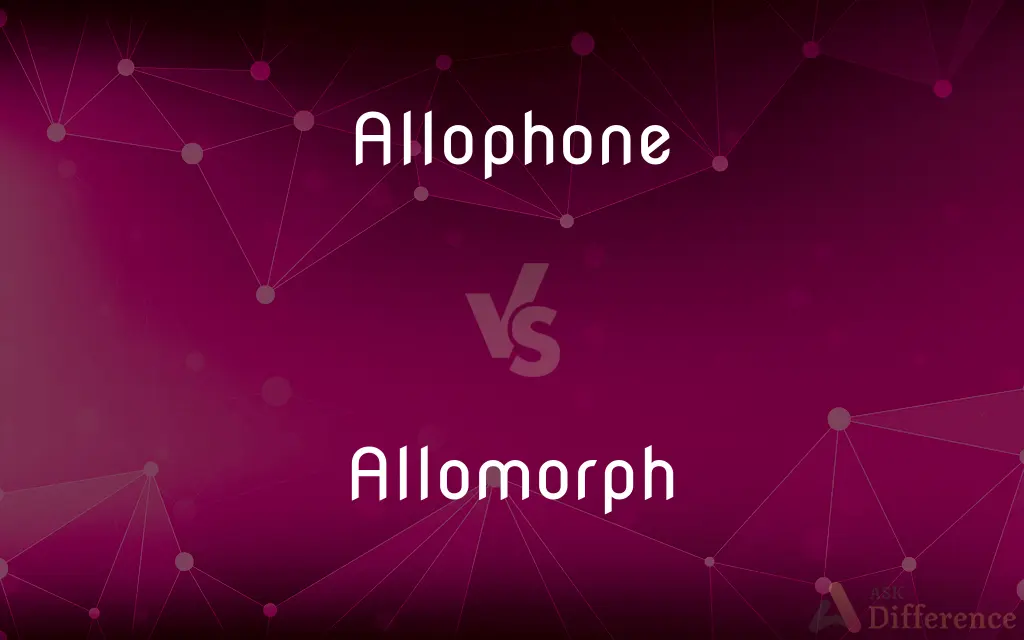Allophone vs. Allomorph — What's the Difference?
By Tayyaba Rehman & Maham Liaqat — Updated on March 13, 2024
Allophones are variations in the sound of a single phoneme, whereas allomorphs are variations of a morpheme that differ in sound but not in meaning.

Difference Between Allophone and Allomorph
Table of Contents
ADVERTISEMENT
Key Differences
Allophones represent the nuanced sounds of a single phoneme within a language that do not change the meaning of words they are used in. For example, the slight differences in the pronunciation of the "p" sound in "spin" versus "pin" in English demonstrate allophones. On the other hand, allomorphs are variations of a morpheme that can occur in different environments without altering the intrinsic meaning of the morpheme itself. An example of an allomorph is the different sounds of the plural marker in English: the "s" in "cats," the "es" in "dishes," and the change in "man" to "men."
Allophones are a phonetic concept emphasizing the acoustic and articulatory properties of speech sounds, highlighting the flexibility within a language's phonology. They exemplify how phonemes manifest differently based on phonetic context without affecting semantic content. Whereas, allomorphs pertain to morphology, the branch of linguistics concerned with the structure of words. Allomorphs reflect the variability in the realization of morphemes, indicating how the form of words can change to convey the same grammatical function or meaning.
The distinction between allophones and allomorphs underscores the broader linguistic principles of phonology and morphology, respectively. Allophones demonstrate the variation within phonemes, serving as a crucial component of linguistic competence and the phonetic identity of languages. Conversely, allomorphs reveal the morphological dynamics at play within a language, showcasing the flexibility and rules governing word formation and grammatical categories.
Understanding allophones is essential for grasping the subtleties of language sound systems and the concept of phonemic variance, which is pivotal for phonology. This understanding aids in phonetic transcription and the analysis of linguistic patterns. Allomorphs, however, are key to comprehending the morphological structure of languages, enabling the analysis of word formation, morpheme usage, and the rules governing morphological variation.
While allophones focus on the sonic variation of phonemes without altering meaning, allomorphs involve changes in the form of morphemes that are context-dependent yet preserve the underlying meaning. This distinction highlights the interplay between sound and structure in language, illustrating how linguistic elements function and vary within different linguistic levels.
ADVERTISEMENT
Comparison Chart
Definition
Variations of a phoneme's sound
Variations of a morpheme
Linguistic Level
Phonology
Morphology
Function
Shows sound variation within phonemes
Shows form variation within morphemes
Example
"p" in "spin" vs. "pin"
"s" in "cats," "es" in "dishes"
Impact on Meaning
Does not change the meaning of words
Does not change the intrinsic meaning
Compare with Definitions
Allophone
A phonetic variant of a phoneme in a particular linguistic environment.
The aspirated p in pin is an allophone of the phoneme /p/.
Allomorph
A variation of a morpheme that changes form but not meaning.
The plural forms -s, -es, and -ies are allomorphs in English.
Allophone
Subtle sound changes in speech that do not alter word meanings.
The t sounds in top and stop are allophones in English.
Allomorph
Forms of a morpheme that appear in different environments.
The prefix in- changes to im-, il-, and ir- in impossible, illegal, and irregular.
Allophone
Sound variations that are perceptually similar but phonetically distinct.
The variations of the s sound in sea and she are allophones.
Allomorph
Variations in a morpheme occurring due to morphological rules.
The indefinite article a changes to an before a vowel sound, demonstrating allomorphy.
Allophone
Variants of a single phoneme that occur in specific phonetic contexts.
Light and dark l sounds in English are considered allophones.
Allomorph
The morphological counterpart to phonological allophones.
The possessive endings 's and the alternation in children's are allomorphs.
Allophone
The manifestation of a phoneme in different acoustic forms.
The k sound in cool versus key showcases allophonic variation.
Allomorph
Different realizations of a grammatical element.
The past tense markers ed, t, and irregular forms in English are allomorphs.
Allophone
In phonology, an allophone (; from the Greek ἄλλος, állos, "other" and φωνή, phōnē, "voice, sound") is one of a set of multiple possible spoken sounds, or phones, or signs used to pronounce a single phoneme in a particular language. For example, in English, [t] (as in stop [stɒp]) and the aspirated form [tʰ] (as in top [ˈtʰɒp]) are allophones for the phoneme /t/, while these two are considered to be different phonemes in some languages such as Thai and Hindi.
Allomorph
In linguistics, an allomorph is a variant phonetic form of a morpheme, or, a unit of meaning that varies in sound and spelling without changing the meaning. The term allomorph describes the realization of phonological variations for a specific morpheme.
Allophone
(Linguistics) A predictable phonetic variant of a phoneme. For example, the aspirated t of top, the unaspirated t of stop, and the tt (pronounced as a flap) of batter are allophones of the English phoneme /t/.
Allomorph
See paramorph.
Allophone
Or Allophone(Canadian) A person whose native language is other than French or English.
Allomorph
Any of the variant forms of a morpheme. For example, the phonetic (s) of cats (kăts), (z) of pigs (pĭgz), and (ĭz) horses (hôrsĭz) are allomorphs of the English plural morpheme.
Allophone
(phonology) Any of two or more alternative pronunciations for a phoneme.
[ʋ] is occasionally considered to be an allophone of /v/
Allomorph
(chemistry) Any of the different crystalline forms of a substance.
Allophone
(Canada) A person whose mother tongue is neither English, French, nor (sometimes) an indigenous language of Canada.
Allomorph
(linguistics) Any of the different phonological representations of a morpheme.
Allophone
A person whose mother tongue is one other than that spoken by the majority.
Allomorph
Any one of two or more distinct crystalline forms of the same substance; or the substance having such forms; - as, carbonate of lime occurs in the allomorphs calcite and aragonite.
Allophone
(Canada) Of or relating to those whose mother tongue is neither English, French, nor (sometimes) an indigenous language of Canada.
Allomorph
Any of several different crystalline forms of the same chemical compound;
Calcium carbonate occurs in the allomorphs calcite and aragonite
Allophone
That which is of a language other than that spoken by the majority.
Allomorph
A variant phonological representation of a morpheme;
The final sounds of `bets' and `beds' and `horses' and `oxen' are allomorphs of the English plural morpheme
Allophone
Any one of two or more speech sounds that considered variants of the same phoneme. For example, the p sounds of pin and spin are allophones of p; and the t sounds of toe stop and catnip are allophones of t.
Allophone
(linguistics) any of various acoustically different forms of the same phoneme
Common Curiosities
How do allophones differ from allomorphs?
Allophones represent sound variations within phonemes (phonology), while allomorphs are variations in the form of morphemes (morphology).
What is an allophone?
An allophone is a variant of a phoneme's sound that does not change the meaning of words in a language.
What is an allomorph?
An allomorph is a variation in the form of a morpheme that occurs in different environments without altering the underlying meaning.
Why are allomorphs important in morphology?
Allomorphs are important in morphology because they illustrate how morphemes can change form to convey the same meaning or grammatical function.
Can a single phoneme have multiple allophones?
Yes, a single phoneme can have multiple allophones depending on the phonetic context.
Are allomorphs dependent on linguistic context?
Yes, allomorphs vary depending on the linguistic context, reflecting changes in morpheme form without altering meaning.
Do allophones affect the meaning of a word?
No, allophones do not affect the meaning of words; they are simply variations in the sound of phonemes.
What role do allophones play in phonology?
Allophones play a critical role in phonology by demonstrating the variability and flexibility within a language's sound system.
How do linguists determine the boundary between allophones and separate phonemes?
Linguists use minimal pairs and phonetic context to determine whether variations in sound constitute different phonemes or allophones of the same phoneme.
How are allomorphs identified?
Allomorphs are identified by their variation in form in different morphological environments, reflecting the same grammatical function or meaning.
Can the concept of allophones help in learning languages?
Yes, understanding allophones can aid in learning pronunciation and the subtleties of a language's phonetic system.
Share Your Discovery

Previous Comparison
Oxford vs. Cambridge
Next Comparison
Intimidation vs. ThreatAuthor Spotlight
Written by
Tayyaba RehmanTayyaba Rehman is a distinguished writer, currently serving as a primary contributor to askdifference.com. As a researcher in semantics and etymology, Tayyaba's passion for the complexity of languages and their distinctions has found a perfect home on the platform. Tayyaba delves into the intricacies of language, distinguishing between commonly confused words and phrases, thereby providing clarity for readers worldwide.
Co-written by
Maham Liaqat













































